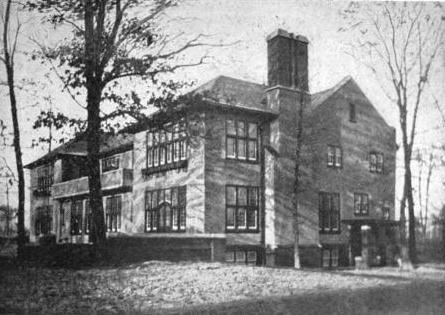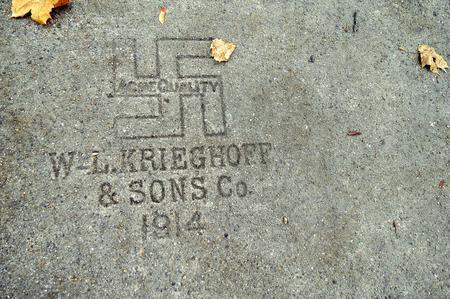CuriosiD: Why Are There Swastikas in Parts of Indian Village?
J. Carlisle Larsen December 17, 2015This week’s installment of CuriosiD investigates a question from listener Savala.

This week’s installment of CuriosiD investigates a question from WDET listener Savala.
“Why are sidewalks in Indian Village stamped with Swastikas? The stamps are uniform and official, like a company laying the concrete made them. Do they predate the Nazi party in Germany? Are they associated with a company affiliated with the Nazi party? The sidewalks are clearly old, but I’m not sure they are date stamped to provide a clue.”
The Short Answer
The short answer is that the “1914” date stamp that I found indicates that these symbols were likely here long before Hitler’s rise to power in 1933.
History of Indian Village
There are a couple parts of Savala’s question. She asks: Why are sidewalks stamped with swastikas? She notes that the stamps look uniform and official—similar to the ones that I found. But—perhaps unsurprisingly—she also wanted to know if the symbols were there before the rise of the Nazi party in Germany.
The short answer is that the “1914” date stamp that I found indicates that these symbols were likely here long before Hitler’s rise to power in 1933. And if we’re trusting the date stamp in the slabs that I found, they would even predate the original founding of the German Workers’ Party in 1919, which ultimately became the Nazi Party. But as to why they’re in Indian Village, we need to look at the history of the neighborhood in the early 20th century.
“The name itself and the name of a couple of streets there reflect a really important part of American Culture at that time. Back in that period we had finally—to use an indelicate term—conquered the West. And all of a sudden Americans kind of embraced the old West and the Indian ways, as much as we had tried to drive the Indian culture away.”
Joel Stone, Senior Curator with the Detroit Historical Society, says in the early 20th century Native American culture was so en vogue that traces of the appropriation appear all over Detroit notably with the symbol which we’re calling the swastika. (In Navajo culture it’s referred to as the “Whirling Log”).
“It was just one of the things that were adapted when we started doing the architecture around here. If you get into some of the old bars in Detroit, you’re going to get swastikas and, of course, they’re in the Penobscot building, they’re in the Skillman branch of the Detroit Public Library downtown,” says Stone.
Prior to the rise of the Hitler in the 1930s, swastikas were actually a pretty common sight in the United States. There are even examples of well-known companies, still around today, using it as part of their advertising in the years prior to World War II. But the symbol’s popularity waned as it became associated with the Nazi party.
Stone says there was even a move on the part of Native American tribes at the time to distance themselves from the swastika because of the Nazis. But the symbol itself is very old—ancient even—with roots in cultures around the world—notably Africa, Asia, and eventually the Americas. It’s sacred in many groups and religions—such as Buddhism and Hinduism.
“It’s had this amazing diaspora. It’s been everywhere and it’s meant various things in those places,” says Steven Heller, co-chair of the School of Visual Arts MFA Design Program in New York. He’s also a prolific author whose work includes examining the branding efforts of totalitarian regimes—such as the Nazi Party. The swastika’s adoption in Europe was extensive…and many groups who adopted the mark imbued it with a mythology that incorporated racist ideologies. Heller says even though other nationalistic groups had adopted the swastika, it wasn’t until Hitler used it that it gained notoriety.
“It was always black and always geometric. He tipped it over to its side a little bit so it looks like a propeller. He put it against a white background with a blood-red field surrounding that and it became the graphic mark that we know and are sort of terrified of today,” says Steven.
Now, the swastika that I found in Indian Village was NOT tipped at the angle, which adds more credence to the idea that it’s likely not connected with the Nazis.
What about the company that laid the concrete?
To answer another part of Savala’s question, she wanted to know if the company that laid the concrete was somehow affiliated with the Nazi Party. I wasn’t able to find too much about the company besides the date of its founding in 1906. There are also U.S. census records indicating that there were a few Krieghoff families in Detroit in the early 20th century, but none could be conclusively tied to the company itself.

Recently, a group of West Village residents have inquired about how to have the concrete slabs removed. The effort begs the question: when and how do you remove historic symbols when they invoke fear?
As Heidi Budaj of the Michigan Regional Director for the Anti-Defamation League says, “What we like to do is look at the intent.” The organization she works for was founded more than a century ago to combat anti-Semitism. Budaj says when people report symbols like the swastika in neighborhoods, her organization seeks context before taking on the case.
“While we would strenuously object to it being spray painted on a street corner in today’s world,” She says. “We would not object to it being used as a design element as it was in the early 1900’s in this country.”
Budaj says while the symbol’s original meaning was to invoke good fortune, she recognizes that people today—regardless of the context of the symbol—can still be taken aback by seeing the swastika in their daily lives.
“When we see it today, it’s very jarring to us because we associate it with Nazi Germany,” she says. “And we know it is one of the most notorious hate symbols used today.”
Budaj says she has received complaints previously about the swastikas in the sidewalk in Indian Village. But the ADL has also fielded other complaints about the symbols in other buildings in the city, such as the Detroit Athletic Club. The DAC has been in the news recently as people have called to have tiles bearing the mark removed.
A member of the West Village residents seeking to have the concrete replaced in her neighborhood…says that effort has been postponed for now. They say that a potential compromise would include placing an educational marker at the location, explaining the Swastika’s original history, while acknowledging that the symbol still invokes fear today.
